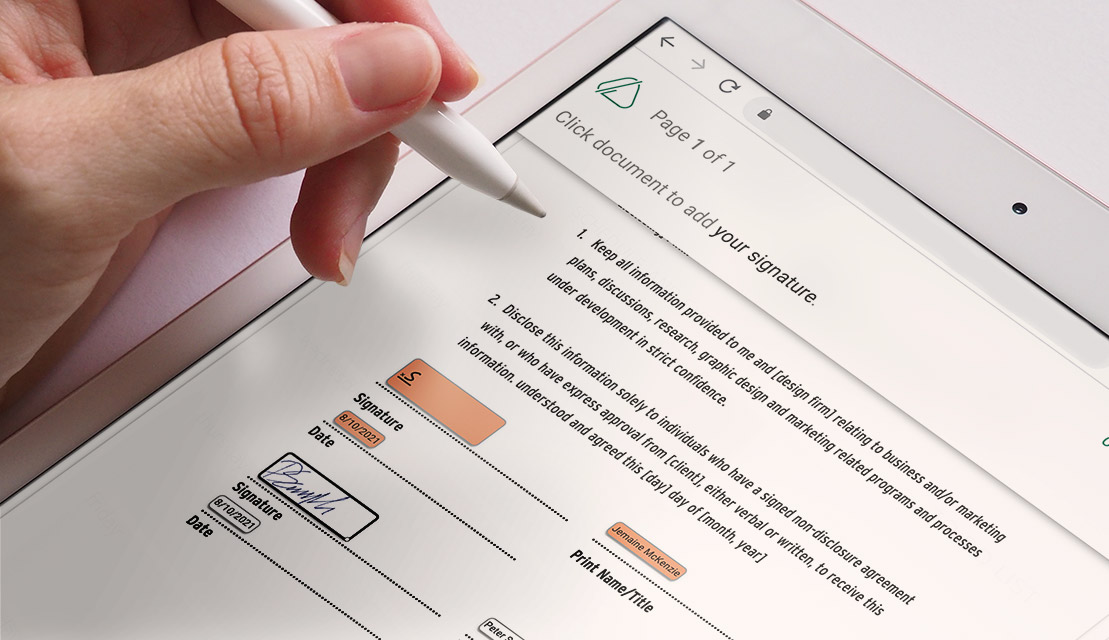E-signatures are the most efficient and highly convenient way of signing digital documents. Using an online e-signature solution allows for contracts and agreements to be signed instantly, rather than printing and sending documents to be signed manually. And since there are ways to verify if an e-signature is real, the risk of getting a forged document is much lower than with traditional signatures.
What are the benefits of using e-signatures?
The US Federal ESIGN Act defines electronic signatures as an ‘electronic sound, symbol, or process, attached to or logically associated with a contract or other record and executed or adopted by a person with the intent to sign the record.’
In simpler terms, e-signatures are signatures that are used electronically in place of signatures made on paper. They are legally binding and are widely used across many industries because of their flexibility and ease. There are also various e-signature laws around the world.
Paperless solutions like e-signatures are also becoming increasingly necessary as more industries go digital. The e-signature market has grown rapidly and is expected to reach $9.07 Billion by 2023.
Some of the benefits of using e-signatures for business are:
- Saving up to 78% on administrative costs spent on pens, paper, ink, and other supplies for physical documents.
- Streamlining workflow by cutting up to a day’s worth of work dedicated to printing, delivering, and waiting for physical signatures.
- Speeding up the signing process by 80% (clients sign within approximately 37 minutes of receiving a document for e-signing).
- Reducing errors by 80% because e-signatures can be deleted and re-done electronically; no need to reprint a document in case an error is made.
- Improving productivity by 85% since most of the time allotted to printing and routing physical documents can be used for other tasks.
With Countersign get your signatures instantly and securely –
from anywhere in the world, at any time.
Get started
How can I verify that an e-signature is authentic?
While e-signatures are globally acknowledged as legally binding, many people understandably hold a certain level of skepticism regarding their authenticity. The good news is there are many ways to verify if an electronic signature is valid.
Furthermore, there are a lot of great tools that can ensure a high level of security when dealing with e-signatures. This is because e-signature service providers are required by law to comply with certain regulations to guarantee the validity of signatures made within their service.
Countersign is an e-signature tool that runs on a secure infrastructure that offers protection against tampering and forgery. In this context, e-signatures can be considered even more secure than traditional signatures.
Generally, here are some ways to spot whether or not an e-signature was made via a legitimate, secure site:
1) A permanent and tamper-proof audit trail
Any legitimate online e-signature solution provides an audit trail of e-signatures that is permanent and unalterable. This means a record of who accessed the document and what changes were made each time. This audit trail can even be used as a piece of evidence in legal proceedings.
2) A way to confirm the signer’s identity
E-signature sites confirm a signatory’s identity and can link the electronic document to signers by way of identification such as:
- Scanned ID Cards
- Security Questions
- Two-Factor Authentication via Call or Text
- Account Password
- Email Address
- Phone Number
- Specific Access Code
- Digital Certificate
3) Proof of Intent
A valid e-signature should show proof of the signer’s intent to agree to a given contract or agreement. This is usually done via:
- Typing in the signer’s name
- Drawing their signature
Such proof is required in most locations for it to be considered enforceable by law.
4) Secure cloud storage and backup
Legitimate e-signature services also ensure that all documents are stored securely in the cloud. This means that the backups ensure utmost security and safety against forgery. In this regard, e-signatures are more secure than traditional signatures because they cannot be imitated in the same way physical signatures can.
Because there’s a secure audit trail and cloud backup, identity thieves cannot copy a signed document and pass it off as legitimate.
5) Encryption and secure infrastructure
Secure sites like Countersign run on a Google-backed secure infrastructure. Therefore, you can rest assured of the full encryption of your network connection, as well as your documents.
Together with a cloud backup, businesses and establishments know that their files are secure even in the event of physical damage or destruction, such as through fires, floods, or earthquakes.
6) Document integrity after signing
If a document has been tampered with after any party signed it, it may appear compromised. However, any secure e-signature system offers users to verify the document by using a cryptographic checksum. The signer can compare the original documents by comparing a mathematical algorithm that is unique to each document. If the numbers do not match up, they will know that the document was altered after it was completed.
Conclusion
E-signatures are a convenient, fast, and secure way to carry out most signings. They are legally binding and are recognized globally under international laws as a legitimate form of signing documents. With the help of a secure e-signature platform, all parties can rest assured that signings are carried out safely and securely anytime and anywhere.
Give Countersign a try on us.
First 5 docs are free. Get 3 more docs free monthly.
Get started





